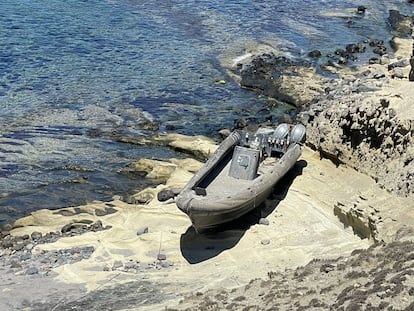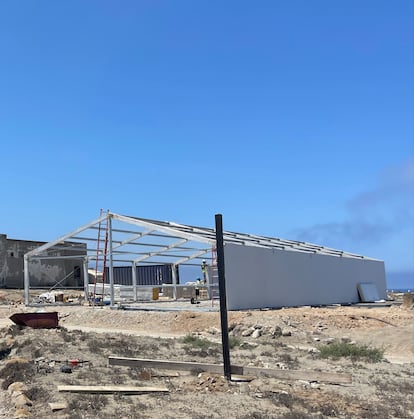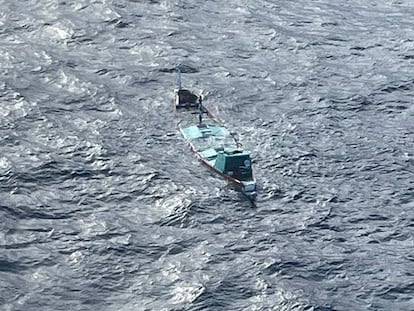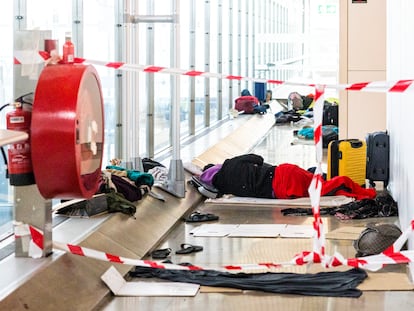The tiny island of Alborán, new target of the migrant mafias in western Europe
The nearly deserted islet, located just 35 miles from the northern coast of Morocco and belonging to Spain, is being increasingly used by smugglers. A total of 11 soldiers stationed there are struggling to handle the surge


The Spanish Army detachment — a total of 11 soldiers — stationed on the tiny island of Alborán, about 55 km (35 miles) north of Morocco and 85 km (53 miles) from the Spanish province of Almería, has a brand new baking facility to make fresh bread. This is the only piece of good news the military have had all week. On Wednesday, a delegation of 13 politicians from mainland Spain, representing all political stripes, visited them and expressed concern at the recent increase in drug boats that are now also using this route (shorter than the others) to introduce undocumented migrants into Spanish territory.
So far this year, the mafias have brought 518 migrants to this flat islet with a surface area of only seven hectares that rises out of the water in the middle of the western Mediterranean Sea. For several months now, Spain’s Maritime Rescue service has stopped transferring the migrants to mainland Spain, which means they spend weeks at a time on the rocky outcrop, where the soldiers lack the resources to care for them until they are eventually transferred by officers from the Civil Guard law enforcement agency. The Ministry of Defense is now erecting a temporary building to somewhat improve the conditions of their stay.
Between January and June, 20 drug boats have stopped in Alborán to drop off 518 undocumented migrants (including 31 minors and 23 women), almost all Moroccan citizens. The skippers are sometimes armed. The soldiers based in Alborán have also noticed that it is often better for them to hide and “not make themselves visible” to the traffickers, so that the latter will not push the migrants into the open sea, in areas with cliffs and difficult to reach.
Defense officials have concluded this route is good for smugglers because it is shorter, cheaper and less dangerous than the one that leads from Morocco to the coast of Cádiz or Almería. Alborán is halfway between the cities of Nador in northern Morocco and Adra in southern Spain.
The military, which have been present on the island since 1997, complain that it is not part of their duties to welcome and care for the immigrants, but rather to protect the sovereignty of a territory that is part of Spain. Defense Minister Margarita Robles traveled to the islet in person on March 11 after Alborán registered 198 arrivals in the month of February alone. The outlook has not improved since then.
Given the evidence that Alborán has become a space of interest for the migrant mafias, in April the Spanish government released €1.3 million to urgently erect a structure in which to temporarily house the new arrivals, after learning that they were spending weeks on an island devoid of any buildings other than a lighthouse. The pavilion is still in a very early stage of construction.

In recent weeks, the Civil Guard has assumed the work of transferring migrants to the peninsula, but these trips that were once handled by Maritime Rescue services and carried out on the same day as the boat arrivals, can now be delayed by several weeks. The island’s infrastructure is limited to a lighthouse equipped to house the soldiers stationed there, a small dock and little else. The terrain is steep and there is one tiny cove next to the dock.
Sources at the Interior Ministry, which oversees the Civil Guard, said that they pick up migrants whenever the weather conditions allow it, but they also emphasized that Maritime Rescue has stopped handling the transfers and that they cannot assume this service.
Sign up for our weekly newsletter to get more English-language news coverage from EL PAÍS USA Edition
Tu suscripción se está usando en otro dispositivo
¿Quieres añadir otro usuario a tu suscripción?
Si continúas leyendo en este dispositivo, no se podrá leer en el otro.
FlechaTu suscripción se está usando en otro dispositivo y solo puedes acceder a EL PAÍS desde un dispositivo a la vez.
Si quieres compartir tu cuenta, cambia tu suscripción a la modalidad Premium, así podrás añadir otro usuario. Cada uno accederá con su propia cuenta de email, lo que os permitirá personalizar vuestra experiencia en EL PAÍS.
¿Tienes una suscripción de empresa? Accede aquí para contratar más cuentas.
En el caso de no saber quién está usando tu cuenta, te recomendamos cambiar tu contraseña aquí.
Si decides continuar compartiendo tu cuenta, este mensaje se mostrará en tu dispositivo y en el de la otra persona que está usando tu cuenta de forma indefinida, afectando a tu experiencia de lectura. Puedes consultar aquí los términos y condiciones de la suscripción digital.
More information
Archived In
Últimas noticias
Most viewed
- Sinaloa Cartel war is taking its toll on Los Chapitos
- Reinhard Genzel, Nobel laureate in physics: ‘One-minute videos will never give you the truth’
- Oona Chaplin: ‘I told James Cameron that I was living in a treehouse and starting a permaculture project with a friend’
- Why the price of coffee has skyrocketed: from Brazilian plantations to specialty coffee houses
- David King, chemist: ‘There are scientists studying how to cool the planet; nobody should stop these experiments from happening’










































